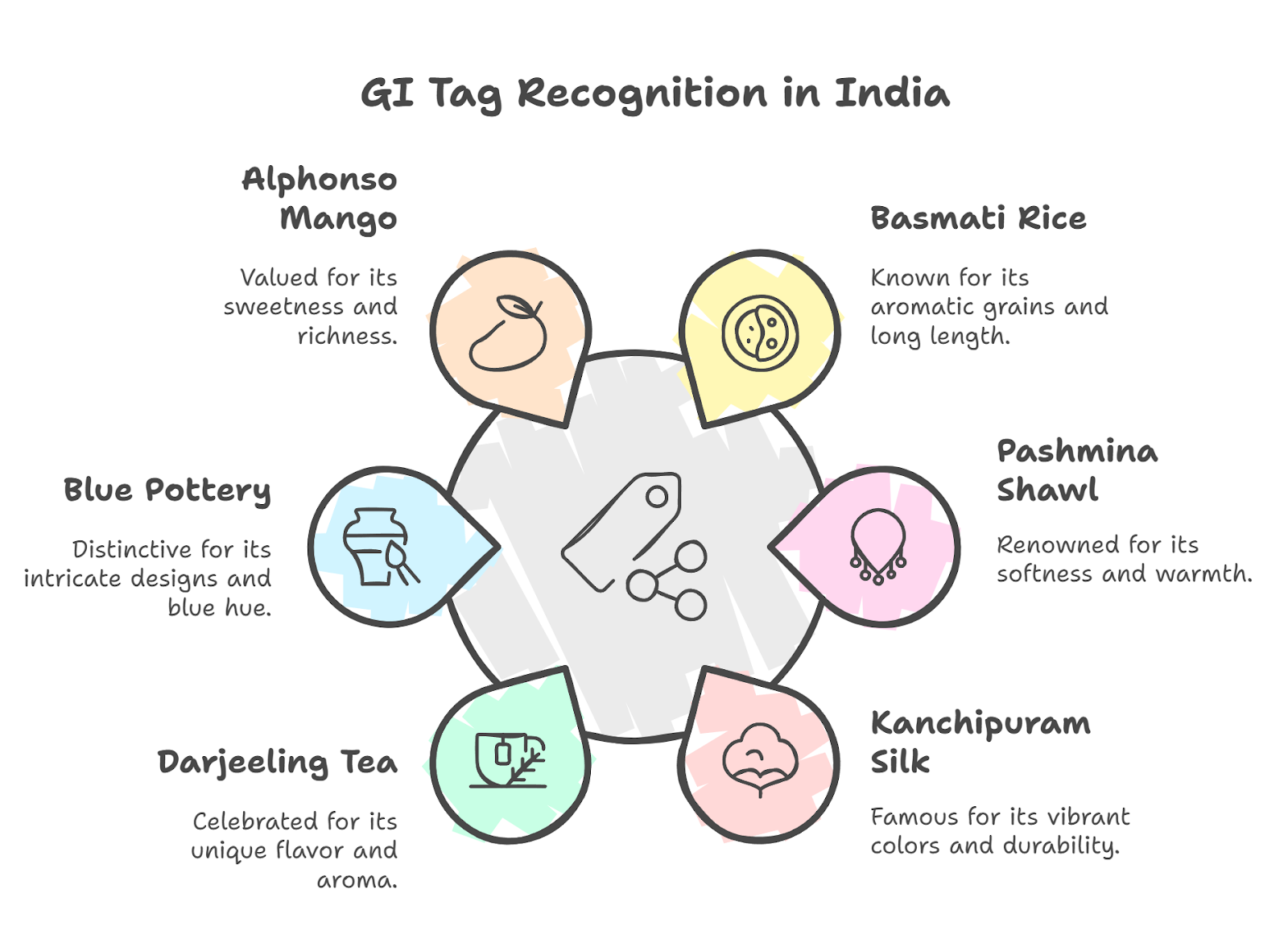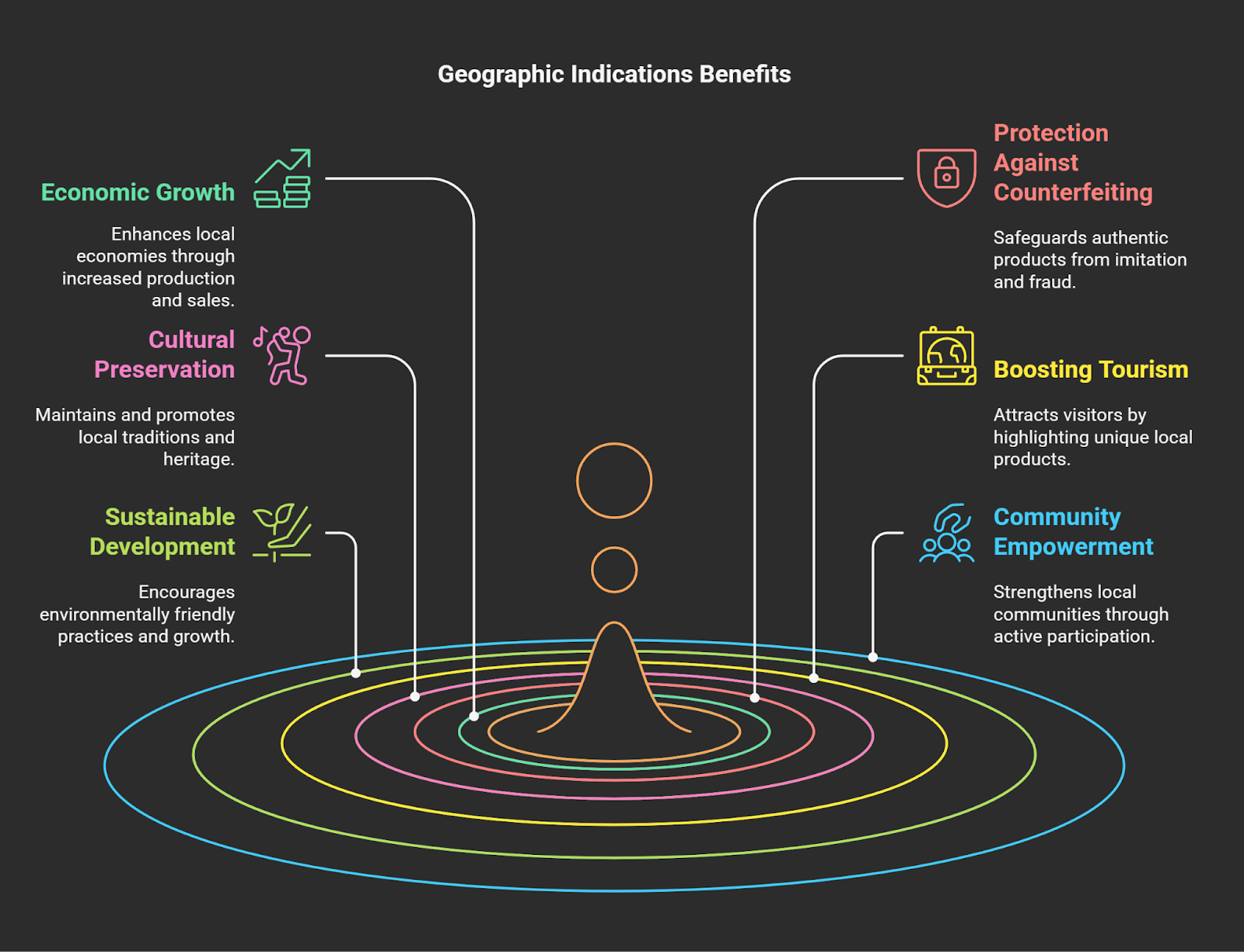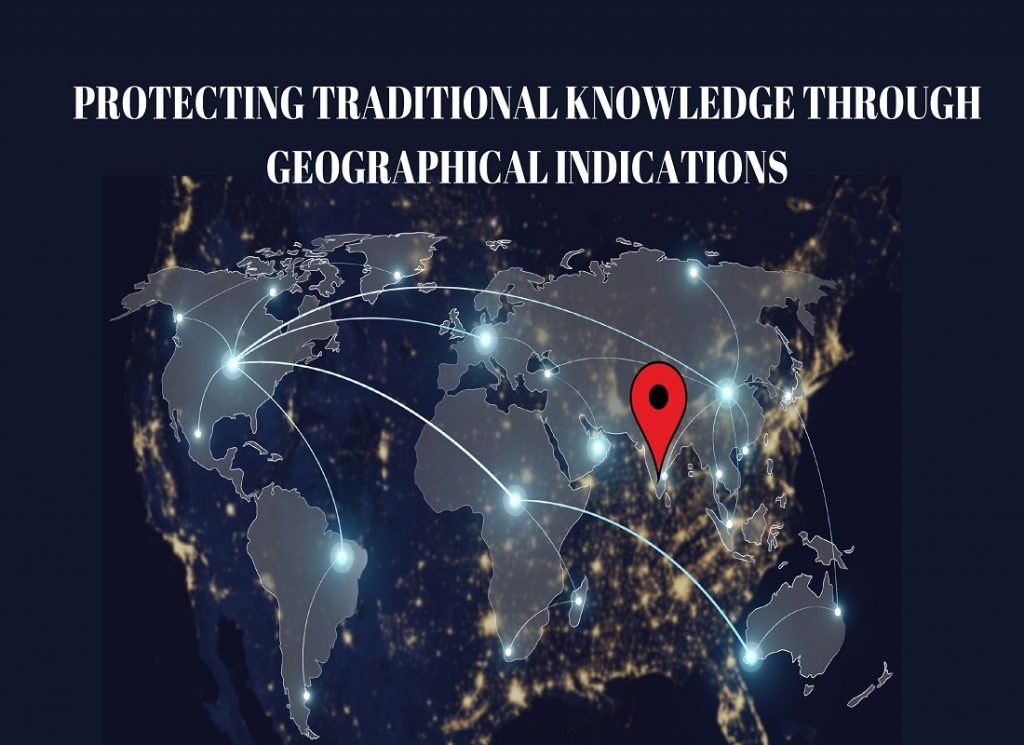If you are wondering about Geographical Indications (GI), and how you can register for one, this article is for you. I have covered the advantages, why you should get one and the significance of it. If you are wondering about the process, that is covered as well.
Table of Contents
Introduction
I went for a short vacation to London and while I was exploring the city, I came across a restaurant which served Indian cuisine. I had been missing home food quite a bit, because how long could you possibly eat British food?
Anyway, I was browsing the menu, and I saw Thalassery Biriyani as one of the options. I thought to myself “No way, can this really be?” So out of curiosity, I ordered it.
And dare I say, it actually wasn’t bad! I was pleasantly surprised but also had this unsettling feeling that this wasn’t right. I’ll tell you why.
I am from Thalassery, Kerala, and I grew up eating this particular biriyani in Thalassery. I also know the people, the hoteliers who make it. It was nice to know that their dish was known worldwide, I mean it made its way to London! But at the same time, they weren’t being recognised or getting profited from it.
You might be thinking, the dish is known by the actual name though and isn’t that cool? Well, it is but then again imagine you have authored a book, and it sells everywhere with your name but it’s not being sold by you, but by other booksellers who print your book which is uniquely yours. Not cool right?
So I did some digging and learnt about Geographical Indication Tag also known as GI tag.
What does it do?
It gives your product protection, your book cannot be GI tagged but other things such as artwork, a traditional method of sewing, etc, can be GI tagged. What it essentially does is, give the said product legal protection. This means that no one else will be able to sell your product, and your name and your product won’t be misused.
I left the restaurant feeling inspired because I wanted to get a GI tag for the famous Thalassery biryani. If you are like me and if you have wondered how to protect your unique local products, this article is for you!
Now, suppose I want to get a GI Tag for the biriyani, through this article, I will tell you the process that I would have followed, but before I walk you through that, let me tell you a little bit more about GI.
What is GI Tag and why does it matter?
According to Section 2(e) of the Geographical Indications of Goods (Registration and Protection) Act, 1999, Geographical Indication is defined as:
“an indication which identifies such goods as agricultural goods, natural goods or manufactured goods as originating, or manufactured in territory of a country, or a region or locality in that territory, where a given quality, reputation or other characteristics of such goods is essentially attributable to its geographical origin and in case where such goods one of the activities of either the production or of processing or preparation of goods concerned takes place in such territory, region or locality as the case may be”
According to the World Intellectual Property Organization (WIPO):
A geographical indication (GI) is a sign used on products that have a specific geographical origin and possess qualities or a reputation that are due to that origin. In order to function as a GI, a sign must identify a product as originating in a given place.
In addition, the qualities, characteristics or reputation of the product should be essentially due to the place of origin. Since the qualities depend on the geographical place of production, there is a clear link between the product and its original place of production.
A Geographical Indication (GI) is a sign used on products that have a specific geographical origin and possess qualities or a reputation due to that origin, it can also include special or unique qualities which make it stand out. It’s like a stamp of authenticity that ensures only products from a particular region can use that name. For example:
- Darjeeling tea can only come from Darjeeling, India.
This was the first product in India to get GI tagged back in 2004.
- Kanchipuram silk is exclusive to Tamil Nadu, India.
- Champagne can only come from the Champagne region of France.
Champagne is actually so fiercely protected, that an American company called their sparkling wine ‘California Champagne’, the company was not only sued but more than 3000 wine bottles were destroyed which was labelled as ‘Champagne’!
GI has been given importance because it just doesn’t protect a product, the idea is to safeguard the traditional knowledge and cultural heritage behind it. Thalassery biryani has been around for nearly a century and a GI tag would prevent anyone else from calling it their own.
For your information, there are over 600 GI-tagged products in India, Darjeeling tea being the first one to get a tag in 2004. All of which can be found here. Here are a few examples of GI Tags in India.

Benefits of Geographical Indications
Beyond preserving traditional knowledge and essentially safeguarding the product, GI brings other benefits as well. If you are wondering what they are, then here are a few:
Economic growth for producers
- GIs provide exclusive rights to producers. So if the producer is from a particular region will be able to charge premium prices for their goods.
- For example, the local tea growers of Darjeeling will have more economic benefits than regular tea producers because of the GI tag.
Protection against counterfeiting
- Not everyone can acquire GI, since there is a process which is very thorough in order for someone to finally attain a GI. Therefore once you acquire a GI, then it will safeguard products from being misused or falsely claimed by others, keeping your product safe and well protected.
- This ensures that only authentic goods can bear the GI, protecting the reputation of the region and the product.
Cultural and traditional preservation
- A country such as India has so much cultural heritage. Many GI products represent centuries-old traditions or unique techniques that might otherwise be lost.
- For example, an ancient metal craft, Bidriware originated in Bidar Karnataka is an intricate inlay work using silver on an alloy of zinc and copper, with a striking black finish. It was introduced in the 14th century and blends Persian, Turkish and Indian influences.
Artisians etch intricate designs by hand and the piece is oxidized using a special Bidar soil which gives it a distinct deep black color. It has been preserved for a tradition as old as 700 years! And not only that, but it also provides livelihood to the skilled artisans in Karnataka.
Boosting tourism
- GI products often attract tourists interested in experiencing the origins of iconic items and this can be because tourists want to try an authentic culinary dish, or they might even want to purchase something from the place of origin.
- For example, did you know that Kanchipuram is known as the “Silk City of India”? Tourists often visit Kanchipuram and they pay a visit to traditional weaving units where artisans create sarees with pure mulberry silk and gold zari work. These sarees sometimes take weeks or months to complete a single piece. The demand for authentic Kanchipuram silk sarees encourages tourists to buy directly from the weavers so that they can receive authentic products and also ensures that the weavers are getting recognition.
Sustainable development
- GI products are the opposite of fast fashion, they don’t follow trends and have been around for a long time. This essentially means that GI encourages sustainable practices and biodiversity conservation since they use traditional methods and local resources.
Community empowerment
- GIs give recognition and financial benefits to small-scale artisans, farmers, and rural communities, fostering socio-economic development.

This may seem odd but, on January 2, 2024, Red Ant Chutney from Odisha, India, was given the GI tag. Red Ants! I was quite surprised when I heard this. It’s a chutney made from red weaver ants. It’s a savoury!
So if you have something unique like this, you can get a GI tag for it too. So how do you do it? Let’s get to it.
Registering a GI
Okay coming back to Thalassery Biryani, how would I have proceeded with the process? Let us take a look.
So my journey to getting that GI tag was going to be challenging. But I think it will also be rewarding. Since this biriyani is from Thalassery, it was already known as Thalassery everywhere so I wouldn’t have had to change the name or give it a new one. If you are also in the pursuit of getting a GI tag, before getting into the actual steps of registration, there are certain things that you need to make sure of from your end. There are:
- Understanding the product uniqueness: I want to obtain a GI for the biryani, the first thing I will have to do is research a few things about the biriyani. I need to document:
- The traditional methods of preparation.
- The unique qualities of the product such as texture, taste, nutritional value etc.
- Its cultural significance in Thalassery, Kerala.
- Forming an association: A GI tag isn’t granted to individuals, it’s given to a group of producers or an association. Because of this, I will have to reach out to the hoteliers who are known to be continuing the legacy of the traditional biryani for decades. So this means getting in contact with the chefs and the hoteliers and forming the Thalassry Biriyani Association. Together, we will have to pool our resources and knowledge to apply for the GI tag.
Procedure for filing a GI application
If you have reached this far, I am pretty sure you want to file an application for GI. So, keep reading. I will break it down for you.
First things first, I have to file an application for GI. It has quite a few details to remember, so do pay attention to all the details.
Form and signing of the application
- Form requirement: I should file the form and also pay a certain fee. You must use the prescribed forms (GI-1A – 1D) with a fee of Rs. 5000/-.
- Signature: The application should be signed by either me or an authorised agent. So for your product get it signed according. No one else can sign the application on behalf of you.
- Copies: The application must be signed in triplicate, along with three copies of a statement of the case and five additional representations.
For example: We, Thalassery Biryani Association have to submit three identical applications, including all supporting documents.
Payment of fees
- Methods: You can pay the fee via cash, money order, bank draft, or cheque.
- Details: Bank drafts/cheques must be payable to the Registrar. This should be done at the appropriate GI Registry office and drawn from a scheduled bank in that location.
- Consequences of non-payment: Applications without fees or with insufficient fees are considered invalid.
Document specifications
- Language: You must file the application in Hindi or English. It can be shall be typewritten, lithographed or printed.
- Format: The paper should be 33 cm with a 4 cm margin on the left.
Signing authority
- Applications must be signed by:
- Authorised signatories for associations of persons or producers.
- Chief Executive, Managing Director, or Secretary for corporations for organisations.
- At least one partner for partnerships.
- Please note that the signer’s capacity must be stated under the signature. You should mention it along with their name in capital letters.
Principal place of business
- Your application must state your principal place of business.
- If you are not from India, then you must furnish an Indian address for service in India.
- If you are part of a corporation, then you must state the board of directors’ details, nationality, and country of incorporation.
Convention applications
For applications based on international conventions:
- You must provide a certificate from the GI office of the convention country.
- Include details of the geographical indication, filing dates, and application numbers from the original country.
Statement of user
Applications must include a statement of usage supported by an affidavit.
For example: I would give mine in this manner:
Thalassery Biriyani Association applying for the biriyani as a GI submits the details of its usage in India.
Application contents
Your application should include:
- Description of the GI’s link to the goods’ origin, quality, reputation, or characteristics.
For example: Thalssey Biryani is a traditional dish originating from the Thalssey region. It is known for its unique blend of spices. This includes aromatic masalas, slow-cooked tender meat, and fragrant seeraga samba rice. The distinct taste and quality of Thalssey Biryani stem from the region’s centuries-old culinary traditions. It also contains locally sourced ingredients. The unique cooking techniques are passed down through generations. The dish enjoys a strong reputation due to its rich flavour. The use of hand-pounded spices, and traditional clay pot cooking methods enhance its authenticity.
- Three certified copies of the goods’ classification
(Attach official classification documents issued by the relevant food or agricultural authorities categorizing Thalssey Biryani under prepared food products.)
Example classification:
- Food Category: Traditional Cooked Dish
- Subcategory: Regional Specialty Biryani
- Classification Authority: Food and Agricultural Standards Bureau
- A geographical map of the territory.
Here I will have to attach a detailed map marking the Thalssey region, highlighting its geographical boundaries, production centres, and main distribution points.
- Description of the GI (words, symbols, and figurative elements).
Here I have to describe the product, so that includes the name, the symbols and also show the figurative elements.
For example:
GI Name: Thalssey Biryani
Symbol: A minimalistic logo of a pot which contains steaming rice.
Figurative Elements: The GI logo includes an illustration of Thalssey’s traditional cooking pot.

- Details about producers and production standards.
Here I will have to cover various aspects like how it is produced, the cooking techniques that is used etc.
For example:
Producers: Local chefs and establishments in Thalssey. They specialize in traditional biryani preparation.
Production Methods:
Ingredient Sourcing: Only locally grown seeraga samba rice can be used. Hand-pounded spices from Thalssey’s spice markets can be used.
Cooking Technique: The meat is marinated for at least 5 hours. The biryani and the masala are cooked separately. Finally, they are mixed together and served directly on the banana leaf.
Serving Tradition: Traditionally served on banana leaves. This is done for the purpose of enhanced aroma and authenticity.
- Mechanisms to ensure quality and consistency.
Here I need to add and mention the process I follow to make sure that there is no lack of quality and consistency of the product.
For example:
Certification Process: Only biryanis prepared following the GI standards can use the “Thalssey Biryani” label.
Training Programs: Local chefs undergo standardized training. This is done to maintain cooking methods.
Ingredient Verification: Suppliers of rice, meat, and spices must be registered and inspected regularly.
- Inspection details and measures for maintaining standards.
For example:
Quality Control Authority: The Thalssey Culinary Heritage Association (TCHA) conducts routine inspections.
Inspection Methods:
Ingredient Testing: Sampling to ensure authenticity. To be done often.
Cooking Process Audits: Unannounced inspections of kitchens to verify compliance.
Consumer Feedback Monitoring: Reports from customers on quality variations.
- Differentiation in cases of homonymous GIs.
For example:
In case another region claims a similar name, differentiation will be ensured by:
Labelling: All authentic products must carry the official “Thalssey Biryani” GI logo.
Origin Marking: Menus and packaging must mention “Produced in Thalssey” to distinguish from other biryanis.
Legal Protections: Any unauthorized use of the name “Thalssey Biryani” outside the registered producers will face legal action.
- Acknowledgement of application
The registrar will provide an acknowledgement and this is done by returning one copy of the representation with the official application number.
These are the things you need to take care of being registering the product. Now to the actual process.
The 10-step process to register a GI in India
Before we dive into the process, take a look at this to get an idea of what the journey would look like to get a GI Tag. If you have questions about the next steps after filing, I’ll tell you what has to be done, step by step.

Step 1: Filing the application
This is covered under Section 11 (2) of the Geographical Indication Act. The first step as discussed above is to file an application in the prescribed format (Form GI 1) with the Geographical Indication Registry in Chennai.
I, along with the Thalassery Biryani Association, will have to submit everything that is mentioned above. Please note that your application must be thorough and well-documented because if there is any missing information, they there can delay the process.
Step 2: Preliminary scrutiny
So, once the application is filed, it undergoes preliminary scrutiny. This will check for completeness. The GI ensures that all required documents are attached. Also, it will make note of the basic documents that are attached. It also ensured that the application meets the basic criteria.
If issues are identified in this process then you will be notified and will be given one month to address the issues.
Step 3: Examination
After the preliminary scrutiny is done, the application is examined by the GI Registry. This involves the following:
- Verifying the claims that are made in the application
- Assessing the evidence provided
- Ensuring the product meets the criteria for a GI tag
Step 4: Show cause notice
This is covered under Section 12 of the GI Act. A show cause hearing will be conducted in case of any discrepancies or issues with the application. You will be given an opportunity to address these concerns.
You must keep in mind that you must respond within two months or request a hearing. The Registrar’s decision is then communicated. If you want to appeal, then make sure to do it in one month’s time.
The Registrar also has the authority to withdraw the application if it was in any case accepted in error. This is done after providing an opportunity for the applicant to be heard.
Step 5: Publication in the Geographical Indications Journal
Section 13 of the GI Act talks about advertisements. Once the application passes the examination, it should then be published in the Geographical Indications Journal. This is a public notice that allows anyone to oppose the application if they have valid reasons.
Take a look at this public notice where it was published for Toscano Wine to get a GI tag!
On what basis can people oppose?
Oppositions can arise due to:
- Claims that the product is not unique to the region
- Disputes over geographical boundaries
- Existing trademarks or similar product names
For example, a legal battle arose between Odisha and West Bengal over GI on the famous sweet rasgulla. It was ultimately granted to both the states for their versions of rasgulla.
Step 6: Opposition to registration
There is a three-month opposition period after publication. Anyone can file an opposition to the application during this given time. The opposition must be supported by evidence. This is covered under Section 14 of the GI Act.
Step 7: Registration
If no opposition is filed, or if the opposition is resolved in favour of the applicant, the GI tag is granted. The product is officially registered, and a certificate of registration is issued. This is covered under Section 16 of the GI Act.
Step 8: Renewal
The GI registration is valid for ten years. It can be renewed indefinitely for subsequent ten-year periods upon payment of the prescribed renewal fee. Certain goods, especially wines and spirits, may receive additional protection. Producers of such goods can request this enhanced protection during the application process. This can be found under Section 18 of the GI Act.
Step 9: Additional protection to notified goods
Certain goods may receive additional protection. Producers of such goods can request this enhanced protection during the application process. This does not have a specific category.
Step 10: Appeal
If an applicant is aggrieved by any decision of the Registrar, they can file an appeal. This can be done under Section 31 of the GI Act. This has to be done before the Intellectual Property Appellate Board within three months from the date of the decision.
A global perspective on GIs
Geographical Indications are recognized internationally as intellectual property rights under the framework of the World Intellectual Property Organization (WIPO). There are three main Treaties enacted for the protection of Geographical Indications under WIPO are listed below.
- Paris Convention
- Madrid Agreement
- Lisbon Agreement

Paris Convention for the Protection of Industrial Property (1883)
- This is one of the earliest treaties addressing the protection of GIs.
- It requires member countries to prevent the use of false indications of origin and unfair competition.
Madrid Agreement for the Repression of False or Deceptive Indications of Source of Goods (1891)
- This is aimed at preventing the misuse of indications of source.
- It obligates member countries to prohibit false or deceptive geographical indications products.
Lisbon Agreement for Protection of Appellations of Origin and Their International Registration (1958)
- Unlike general GIs, Appellations of Origin (AO) emphasize a stronger connection between the product’s quality and characteristics and its geographical origin.
- This agreement prevents unauthorized use of the registered name, even if the true origin of the product is indicated (eg. like Darjeeling Tea but grown elsewhere)
It is important to note that India is not party to the Lisbon Agreement but adheres to the TRIPS Agreement for GI protection.
TRIPS Agreement (1995)
- The Trade-Related Aspects of Intellectual Property Rights (TRIPS) Agreement is administered by the World Trade Organization, this is the most comprehensive treaty governing GIs.
- It mandates all member countries to provide a minimum level of protection for GIs.
- Special provisions are included for wines and spirits, offering them enhanced protection.
If you are looking for more information, national and regional laws governing the protection of geographical indications can be searched here.
What is India’s role in the global GI landscape?
India’s GI registry, established under the GI Act, of 1999, has aligned itself with international standards. Indian GIs such as Darjeeling Tea, Mysore Silk, and Pashmina shawls have gained recognition in global markets. This has enhanced India’s cultural presence.
If you wondering about the possibility of GI registration internationally, then yes it is possible to secure a Geographical Indication (GI) tag internationally to protect your product in foreign markets. International GI protection is crucial to prevent the misuse or counterfeiting of your product abroad.
If you are wondering how to do it, here’s how:
Ways to secure international GI protection
- Through bilateral agreements
- Countries can enter into bilateral agreements to mutually recognize and protect each other’s GIs.
- For example, India has bilateral agreements with the European Union for products like Basmati Rice and Darjeeling Tea.
- Using TRIPS Agreement
- If a country is a member of the WTO and adheres to TRIPS, then GI will be protected in that country under its domestic laws.
- TRIPS provides a baseline of protection and requires all member countries to prevent the misuse of registered GIs.
- National GI registration in foreign countries
- You can directly apply for GI registration in specific countries where you want protection, using their domestic GI laws.
For example:
- In the European Union, you can apply under the PDO (Protected Designation of Origin) or PGI (Protected Geographical Indication) systems.
- In the United States, you can apply for a GI as a certification mark or collective mark under trademark law.
Steps for national GI registration abroad
- Identify the country’s GI registration authority (e.g., EU Intellectual Property Office for Europe).
- File an application in the prescribed format, often requiring proof of origin, uniqueness, and linkage to geography.
- Pay the registration fees and follow the required examination process.
Examples of international GI success
- Darjeeling Tea: Darjeeling tea was registered in the EU under the PGI system. This was done after receiving a GI tag in India. This was a way of ensuring exclusive rights to the name in European markets.
- Basmati Rice: This is protected under bilateral agreements between India and specific trading partners. This essentially prevents misuse in those regions.
Conclusion
If you have reached here, then you must now understand that Geographical Indications are more than just labels, they can be seen as a powerful tool. It is a tool for protecting cultural heritage, empowering local communities, and promoting economic growth.
If you are looking to get a GI tag, then it will not only add value to your product but will also open doors to global markets bringing in that much more recognition to your product.. While the registration process, both domestically and internationally seems a little complex, you should just make sure to navigate them properly. This should be done because I believe that the benefits outweigh the challenges.
The world is becoming increasingly interconnected. GIs essentially act as a bridge between tradition and modern commerce allowing communities to benefit while preserving their legacy.
So it doesn’t matter whether you’re an artisan, a farmer, or an enthusiast of unique regional products. You must know that understanding and utilizing the GIs is a step forward in protecting your cultural wealth!
So, what are you waiting for? Get your product tagged now!






 Allow notifications
Allow notifications
